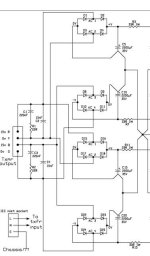Just a thought I had. Could rail sag be reduced in a stereo amp by inverting one channel? You'd keep correct phasing by swapping +/- output labels on that output, but then the large bass signals common to both channels pull current from different filter caps, rather than the same one. You could also use this to drive a mono speaker in bridge mode.
Yes, this has been done years ago by several companies.
Dynaco even specified the power ratings on some of their solid state amps when the channels were being driven out of phase.
Dynaco even specified the power ratings on some of their solid state amps when the channels were being driven out of phase.
This was common on car amplifiers with a SMPS, good exemple is the Pioneer GM2200, i own of those and the negative
output of one channel is actually the hot output of one of the power amp.
output of one channel is actually the hot output of one of the power amp.
I think this has been a trick common for 'rail pumping' in class D amps, but also good for solid state amps. I use it myself in my active setup woofer amp, easy to invert the signal in the DSP and swap the speaker leads 🙂
Yamaha used that trick back in the 70s, some of their preamps had both normal and inverted outputs to do just that.
Craig
Craig
The first iteration of the NAD 2200 employed that approach, though they did change. It appears that only early models with Sanken transistors (rather than 1302/2381) for the class G had this topology.
Oh well, there goes my patent application (!)
Don’t worry, keep thinking
It seems to do more than share the load better across rails (as bass is usually recorded mono), crosstalk inverts too which seems to add air to the sound. Definitely artificial, but I like it nonetheless
Brian
It seems to do more than share the load better across rails (as bass is usually recorded mono), crosstalk inverts too which seems to add air to the sound. Definitely artificial, but I like it nonetheless
Brian
Drawing power from both rail caps simultaneously is better than alternating between them at twice the load. Its like dropping the power supply impedance by a factor of 4, without spending a dime more.
This is something I considered due to the grounding issues - generally caused by GNFB loops.
When a transistor conducts on the +ve side, current flows through the speaker, back to the ground. Unless this is a superconductor, this current pulls the ground up, +ve. The GNFB loop means you have to connect this exact ground to the small signal bits that monitor the feedback voltage, or bad things happen...
So the power amp ground dictates how the small signal ground dances about.
But: if you have both stereo amps out of phase, both pull ground equally (mono signal) so ground doesn't dance. If not, it just gets worse 😀
So there's another reason why it should sound better 🙂
When a transistor conducts on the +ve side, current flows through the speaker, back to the ground. Unless this is a superconductor, this current pulls the ground up, +ve. The GNFB loop means you have to connect this exact ground to the small signal bits that monitor the feedback voltage, or bad things happen...
So the power amp ground dictates how the small signal ground dances about.
But: if you have both stereo amps out of phase, both pull ground equally (mono signal) so ground doesn't dance. If not, it just gets worse 😀
So there's another reason why it should sound better 🙂
One thing to maybe consider would be the inversion of distortion phase too, IF the amplifier distortion is audible, and if it's phase effect the sound..
Small signal ground should NEVER bounce with respect to speaker ground. Tie them to the same place. The center tap of the transformer a and junction between the two reservoir caps can bounce around all it wants with respect to THAT and it won’t mess up sound quality. It can affect maximum voltage swing, but below clipping it should be invisible.
I think there is some exception to the above, and I believe that would be concerning the PSRR of the amp. However on a well designed, high loop gain amp with global feedback, it would be the case.
Factor of two. Half the current, same voltage.Drawing power from both rail caps simultaneously is better than alternating between them at twice the load. Its like dropping the power supply impedance by a factor of 4, without spending a dime more.
- Home
- Amplifiers
- Solid State
- Reducing rail sag by inverting one of the stereo channels?
